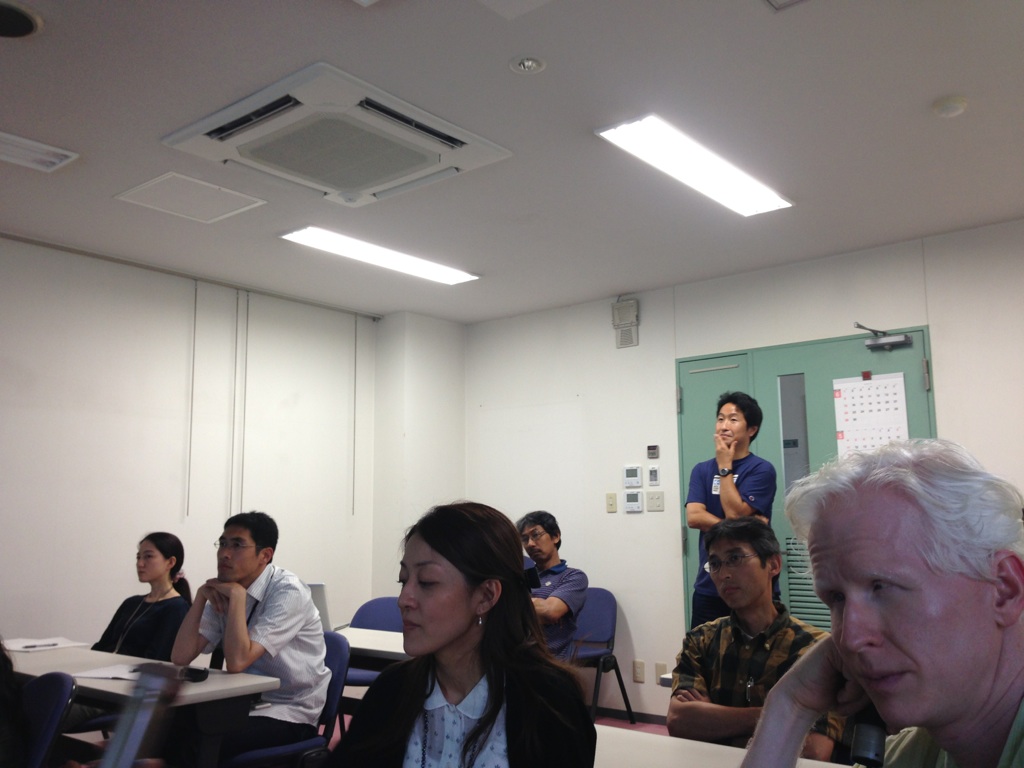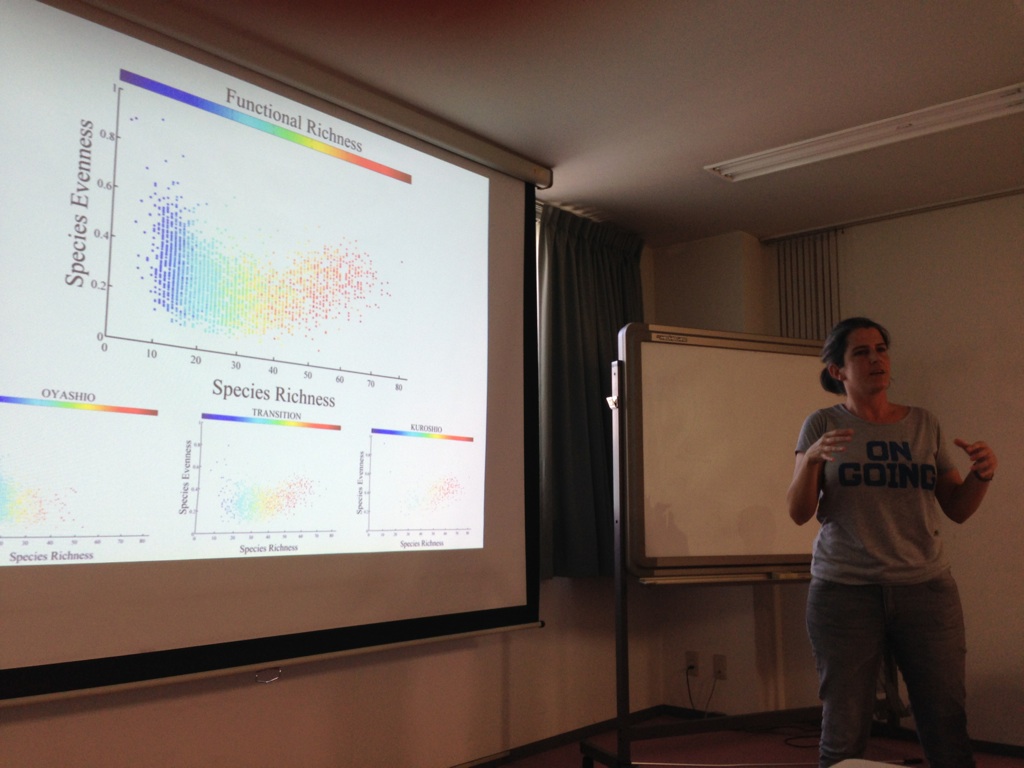Schedule
| Mar 18, 2015 | Yokohama | Miyako Sato | Yuriko Nakamura | Tomoko Yoshiki |
March 18, 2015
Tomoko Yoshiki
"Influence of the Pacific Decadal Oscillation on carbon flux through phytoplankton community structure in the western North Pacific"
Abstract
The photosynthetic fixation of CO2 by phytoplankton and subsequent carbon transport of the particulate matter to the ocean’s interior plays an important role in regulating global CO2 on longer time-scales. The effect of the climate change on carbon export through variations in phytoplankton community structure was not elucidated, although estimations of impact of global warming on the carbon export were conducted by using calculation and modelling studies. In the present study, relationship between interannual variations in phytoplankton community structure in the surface and carbon export in western North Pacific was explored by using time series data of CPR and sediment trap during 2000-2012. Significant positive relationships between variations in diatom cell abundance in the surface and biogenic carbon and opal flux at 4810 m depth were detected. This indicates that diatom variation is most effective on the flux of the organic carbon. Main components of phytoplankton groups were diatom and dinoflagellate. We examined relationship between relative abundances of diatom and dinoflagellate variations and SST associated with PDO index. Positive and negative correlations between running means of SST and diatom cell abundance, and dinoflagellate ratio were detected. This result suggested that warm SST in early spring during negative PDO phase increased diatom production and export flux in western North Pacific.

Feb 19, 2015
Eko Siswanto
"Ocean Color Observations for Ocean Acidification Monitoring"
Abstract
Polar and subpolar regions are bellwether for global ocean acidification (OA), as they will be the first marine environments to become undersaturated with respect to aragonite due to rising anthropogenic carbon dioxide. The OA is expected to be detrimental to marine calcifiers, as it will reduce coccolith precipitation by calcifiers. Within the marine calcifiers, coccolithophores produce the smallest coccoliths having strong light-backscattering. Thus, anything that will affect coccolithophore (including OA) will likely affect in-water optical properties or the color of the ocean. Owing to coccolithophore optical properties, this presentation will introduce how ocean color remote sensing can be exploited for, and can offer a low-cost, potential approach for global/basin-scale and long-term observations of the OA.
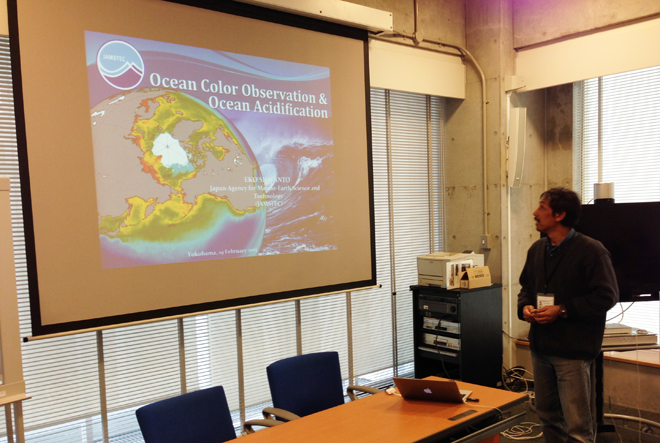
Haruka Takagi
"Culture experiment to reveal trophic interaction of photosymbiosis in planktic foraminifers"
Abstract
Photosymbiosis of planktic foraminifers is considered to be an important ecological strategy to live in oligotrophic open oceans.
However, the trophic interaction between the host and the symbionts are not well understood. To understand the relationship, we here conducted culture experiments and analyzed vitality of host-symbiont consortia under controlled nutrient conditions. We cultured dinoflagellate-bearing species Globigerinoides sacculifer for two weeks. Assuming the two sources of nutrients for symbionts, i.e., from the host’s metabolites and from the ambient seawater, we controlled feeding regime (fed Artemia every other day or unfed) and nutrient concentration of culture media (0.22-µm filtered seawater [SW] or nutrients-added filtered seawater [NSW]). Considering these factors, four experimental groups are set; (a) fed and SW, (b) unfed and SW, (c) fed and NSW, and (d) unfed and NSW. Test growth of the host, chlorophyll content (calculated from Fm), and photo-physiology of the symbionts (potential photosynthetic activity, Fv/Fm) were used as criteria of their vitality.
The results showed that the growth of the specimens in unfed groups (b and d) was significantly inhibited. However, unexpectedly, their Fv/Fm were significantly higher than those of fed groups (a and c). From the fact that foraminifers maintained their life and symbionts were capable of photosynthesis in starved condition, we can conclude that foraminifers could survive only by photosynthates derived from the symbionts at least for two weeks. If this relationship is true in natural environment, photosymbiotic interaction should help foraminifers to survive for certain duration even if they cannot capture any prey. This should be an advantage for them to live in low nutrient and well-lit environment.
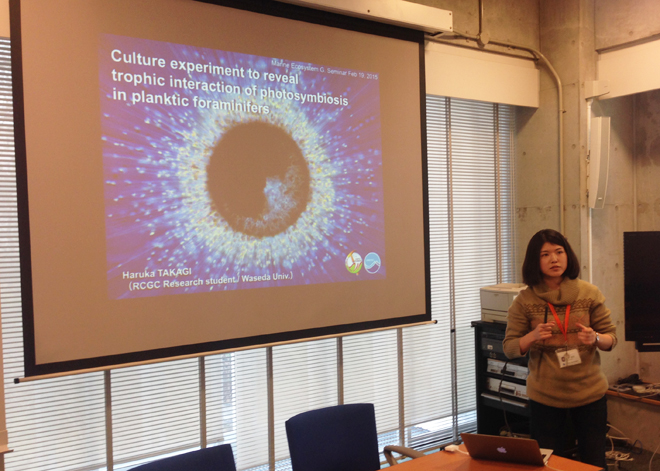
Feb 6, 2015
Bingzhang Chen
"Are marine phytoplankton less sensitive to warming than heterotrophs? – Seemingly trivial statistical problems can lead to erroneous big claims"
Abstract
The direct effect of temperature on phytoplankton growth and metabolism is of critical importance in determining the response of primary production and ecosystem dynamics to warming in the ocean. A number of studies published on first-class journals have reported that the temperature sensitivity of phytoplankton growth rate or photosynthesis (in terms of Q10 or activation energy) is lower than that of heterotrophic activities (e.g. zooplankton grazing or respiration), thus leading to the claim that the ecosystem would be more heterotrophic under ocean warming. I would argue that these claims are based on problematic estimations of temperature sensitivity derived from ordinary least square (OLS) regressions for which the critical assumptions are often not met. If using appropriate regression techniques, we would find that the temperature sensitivity of marine phytoplankton is not significantly different from that of heterotrophic metabolism, invalidating the previous big claims.
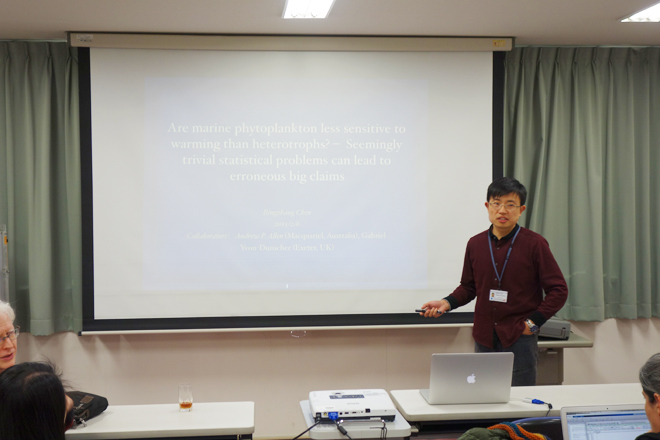
Yoshikazu Sasai
"Interannual variability of Kuroshio nitrate flux and transport along western boundary in the North Pacific"
Abstract
An eddy-resolving coupled physical-biological ocean model has been employed to examine the interannual variability of nitrate flux and transport mechanism by the Kuroshio during 1995-2012. The Kuroshio provides an advective flux of nitrate carried in subsurface waters, redistributing nitrate from the tropics to the mid-latitude. Some observed data capture the nitrate flux and transport in the subsurface layers by the Kuroshio. The maximum nitrate flux core appears about 400 m depth in the East China Sea, and the nitrate transport by the Kuroshio had a mean of 170 kmol s-1. The model reproduces the maximum nitrate flux core in the subsurface layer from the Luzon strait to the Kuroshio Extension with the downstream. Along the vertical section of east side of Taiwan (24 $(D"6N), west side of Okinawa (28 $(D"6N), south of Kagoshima (130 $(D"6E), the time series of nitrate flux, volume transport, and nitrate concentration show the interannual variation. The variability of nitrate flux is strongly correlated with the variability of Kuroshio volume transport, but the nitrate concentration shows the increasing trend between 1995 and 2008. This trend may be related to the variability of nitrate concentration in the upstream of Kuroshio.
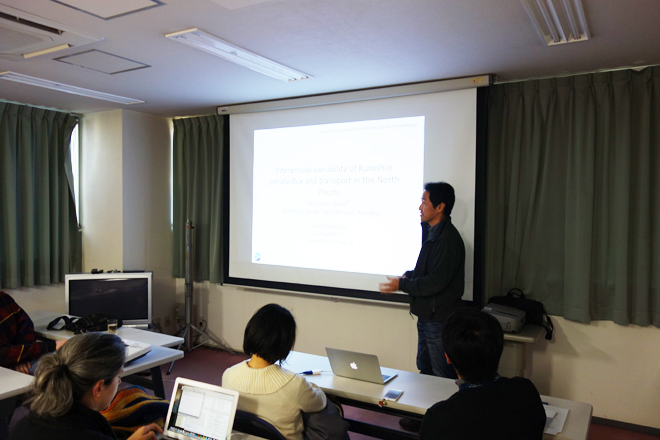
Jan 22, 2015
Maki Noguchi Aita
"Theoretical consideration of metabolic pathways behind linear relationship between carbon and nitrogen stable isotope ratios of the food chain"
Abstract
The δ15N and δ13C of animals are well-known to be enriched in their trophic interaction. We focus on the ratio of C and N trophic fractionation (∆δ15N/Δδ13C), which could be obtained as the slope of the regression line for each food chain on the δ13C-δ15N map. In the latest studies, Aita et al. (2011) and Wada et al. (2013) reported that there is not a big difference in ∆δ15N/Δδ13C between marine and terrestrial food chains. Here, we developed a mechanistic model of the isotopic fractionation in metabolic processes that are common to animals composing most grazing food chains. Particularly, we calculate fluxes of carbon and nitrogen stable isotopes within an organism by following fluxes of molecules involved in some of physiological reactions: the synthesis of amino acids and their carbon skeletons. The rates of are governed by energy-producing systems such as glycolysis, the TCA cycle, and oxidative phosphorylation that is the ratio of the rate of amino-acid syntheses to that of energy-yielding processes. The active metabolic pathways above are assumed to be changed by the conditions of supply (diet quantity and quality) and demand (growth rate). This gives mechanistic insight to what information we can acquire from the observation.
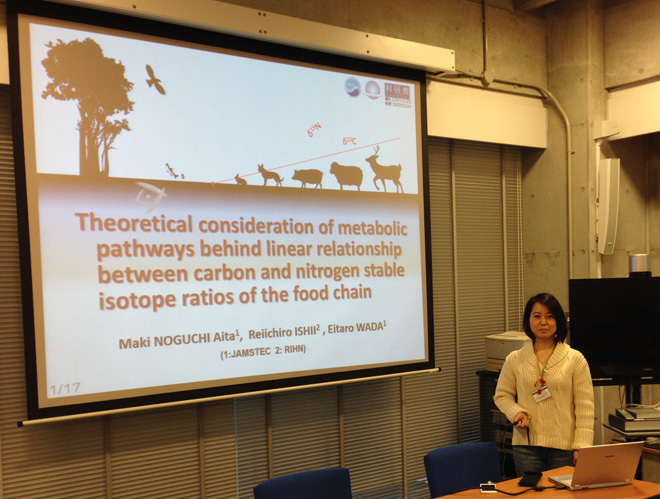
Minoru Kitamura
"Fukushima-derived radiocesium in oceanic zooplankton communities in the western North Pacific: horizontal distribution and temporal change"
Abstract
The magnitude of the 9.0 Tohoku earthquake and ensuing tsunami on 11 March 2011, inflicted heavy damage on the Fukushima Daiichi Nuclear Power Plant. Fission products were emitted and falling over the broad range of the Northern hemisphere. Although the emitted radionuclides were detected not only from terrestrial but also marine biota, studies on the influences of the Fukushima accident to marine biota in oceanic area have been scarce. In this study we described (1) horizontal distribution of the Fukushima-derived radiocesiums in oceanic zooplankton 10 months after the Fukushima accident, and (2) temporal change of the radiocesiums in oceanic zooplankton between one month and three years after the accident.
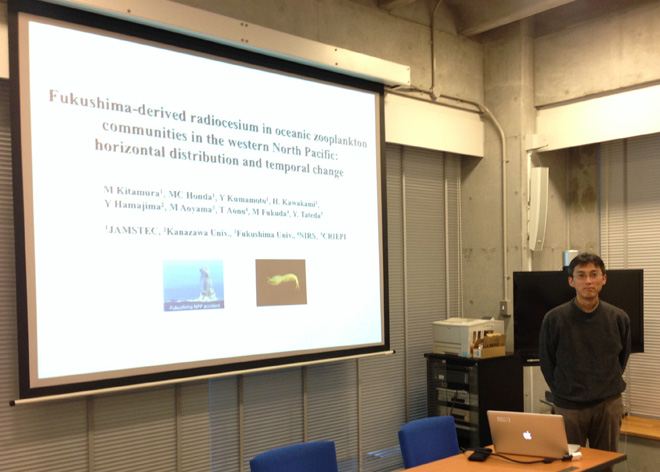
Jan 8, 2015
Tetsuichi Fujiki
"Seasonal variability of phytoplankton composition in the subtropical western North Pacific"
Abstract
The North Pacific subtropical gyre (NPSG) is generally considered as oligotrophic environment through a year because strong stratification in the water column prevents the nutrient supply from deep waters. In the NPSG, phytoplankton community is low biomass at the surface due to nutrient depletion and forms a deep chlorophyll maximum (DCM) at the depth below the top of the nitracline where nutrients are enough to support growth. Additionally, the phytoplankton community is dominated by small-sized cells, such as Prochlorococcus, Synechococcus, and picoeukaryotes, which have high surface area-to-volume ratios leading to efficient nutrient uptake. Thus, in the NPSG, the spatial and temporal variability in phytoplankton community have been traditionally considered small due to chronic nutrient limitation. On the other hand, a time series of chlorophyll a (Chl a) maps in 1997 to 2013 from satellite ocean color remote sensing showed the occurrence of winter blooms in the northwest region of the NPSG. The phytoplankton species composed of the DCM might contribute the winter bloom formation in this region, but species composition of the blooms is not yet understood. Phytoplankton plays key roles in the biogeochemical cycle and food web dynamics in the ocean, and the variations in phytoplankton biomass and species composition will affect various process such as nutrient cycling, zooplankton grazing and particle sinking. Here, we show the seasonal variability of the phytoplankton community (abundance, size, and taxonomic composition) as well as the physiological state of the phytoplankton with respect to photosynthesis in the northwest region of the NPSG.
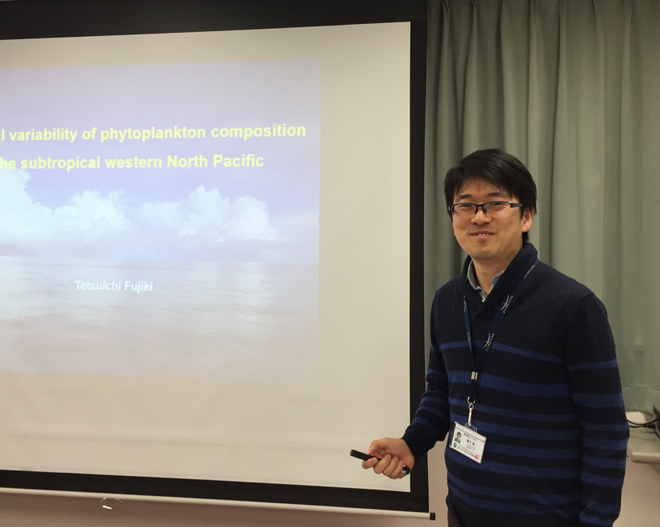
Katsunori Kimoto
"Culture experiment of planktic foraminifera under controlled pCO2 environment"
Abstract
Improving culture techniques for living planktic foraminifers in laboratory is needed to know relationship between their biological responses and oceanic environmental changes. In 2011, we installed an instrument of flow-through pCO2-adjustable water circulation system for continuous culture of planktic foraminifera in Yokosuka Head quarter. Flow-through culture systems have long been attempted for culture studies of marine plankton. However, they have not been used for the culture of planktic foraminifera, because these organisms are positively buoyant and can easily flow out of the culture system through the drain or overflow. Flow-through culture systems, with their monitoring of chemical parameters, have the potential to follow the biological and geochemical influences of dissolved gases (e.g., O2, CO2) and related carbonate-system parameters (pH, alkalinity, and carbonate species) in seawater. Culture experiments of planktic foraminifera under four different pCO2 conditions had started on 2013 and succeeded to build some new chambers for some species in each conditions. In this talk, I will introduce the details of above equipment and show the first results of MXCT images of new developed chambers.
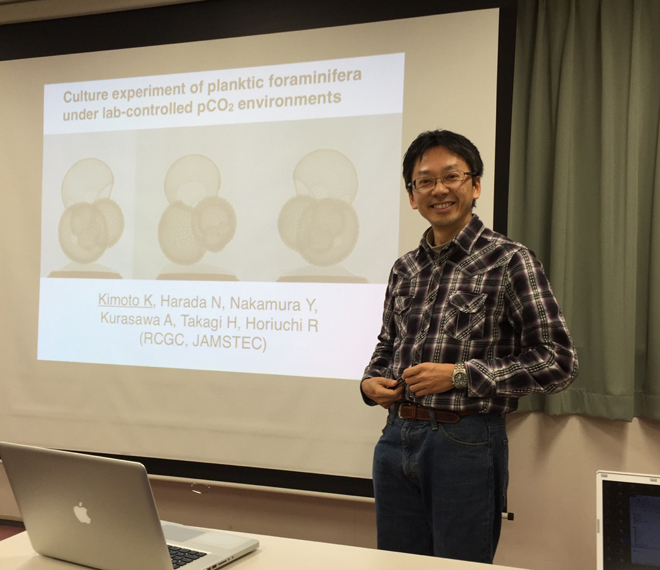
Dec 18, 2014
Sanae Chiba
"Large-scale climate control of zooplankton transport and biogeography in the Kuroshio-Oyashio Extension region"
Abstract
We studied decadal-scale climate control of zooplankton biogeography driven by Kuroshio Extension (KE) dynamics using long-term zooplankton data and an advection model driven with currents from the Earth Simulator eddy-resolving ocean model. Passive tracer model experiments indicated that warm-water species transported from the south were retained in the Kuroshio-Oyashio Extension (KOE) region during years with a weak KE. A 2.5-year lag in the North Pacific Gyre Oscillation (NPGO) index was significantly correlated with the KE strength and with warm-water species abundance. These findings indicate that climate signals from the central and eastern North Pacific propagated westward, influencing not only transport in the KOE region but also regional ecosystem variability. Because the NPGO controls important aspects of the transport dynamics and ecosystem variability in the eastern North Pacific, this study provides additional evidence that large-scale climate patterns drive coherent changes in ecosystems throughout the North Pacific by impacting regional-scale transport dynamics.
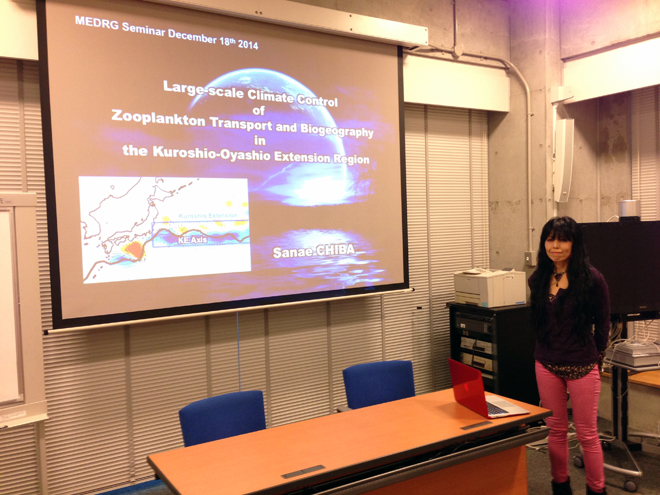
Carmen Garcia-Comas Rubio
"Plankton size diversity effect on community structure and functioning"
Abstract
The role of body size in modelling food web dynamics is gaining increasing recognition. However how size structure influences functioning (e.g., trophic transfer) remains poorly quantified in empirical studies. In this seminar, I will show you some of my recent efforts on empirically exploring the effect of size diversity on structure and functioning of plankton communities.
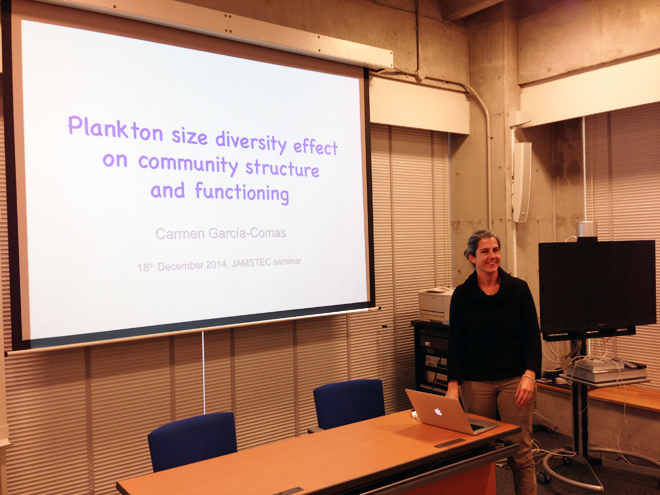
Dec 4, 2014
Naomi Harada GL
"Decadal response of biogenic particle fluxes to Aleutian low variability"
Abstract
Subarctic western North Pacific is one of the strongest area interns of biological drawdown of seawater pCO2 in the world. The dominant primary producer in this area is diatom and effective biological pump works there.
According to the previous studies, a hypothesis that major controlling factor of phytoplankton production is atmospheric circulation such as Aleutian low system through decadal time scale process. I will present how do marine ecosystem respond on decadal timescales to Aleutian low forcing using decadal biogenic flux data from sediment trap experiment obtained at subarctic North Pacific and the Bering Sea and analysis of CESM model.
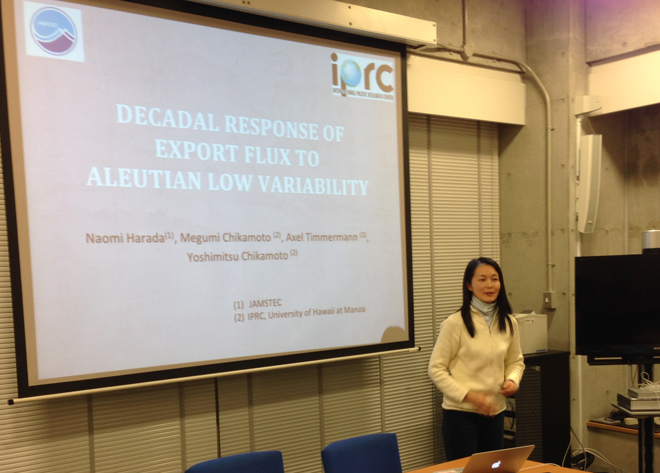
Kana Nagashima
"Asian dust input to the North Pacific and its seasonality"
Abstract
The possible connection between the Asian dust (iron) inputs and primary productivity in the HNLC region of the North Pacific is still unsolved.
Since model estimations of Asian dust input to the North Pacific have large uncertainty, especially for its seasonality, we need reliable observational/proxy records showing seasonal and interannual variations of Asian dust input to the HNLC region to examine the linkage between the iron supply through the dust and primary production in marine waters.
Here we present our preliminary results showing the seasonal and/or interannual variations of Asian dust input during the last several years to decades based on the chemical analyses using annual-laminated lake sediments from Japan and an ice core from Canada. In addition, we compare these results with surface meteorological data in China and Mongolia, and found that Asian dust input to the North Pacific is not limited during spring, but extended to summer and fall, although there is a large annual variations.
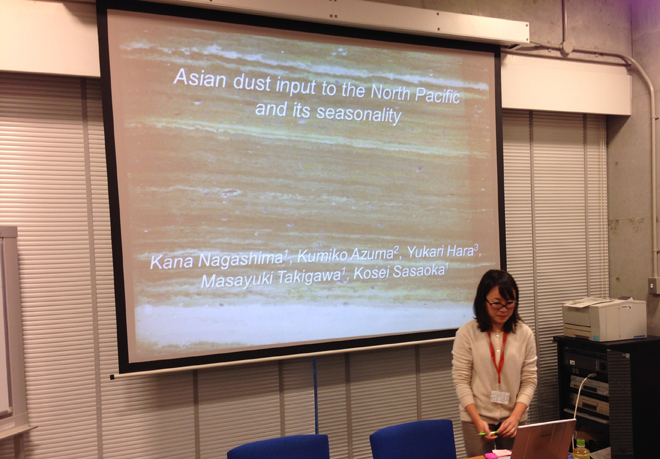
Nov 20, 2014
Taketo Hashioka
"A new“ecological geography of the sea” based on phytoplankton physiology"
Abstract
Longhurst et al. (1995) proposed 54 biological provinces in the world ocean based on the regional difference in seasonal variation of chl-a concentration. This is one of the most famous “ecological geography of the sea”. We propose a new“ecological geography of the sea” based on phytoplankton physiology. Namely, we defined 21 biological provinces based on regional differences in regulation factors of photosynthesis which characterize the seasonal variation of chl-a concentration. This is a challenge that shifts from a similarity based categorization to a mechanistic understanding of regional differences.
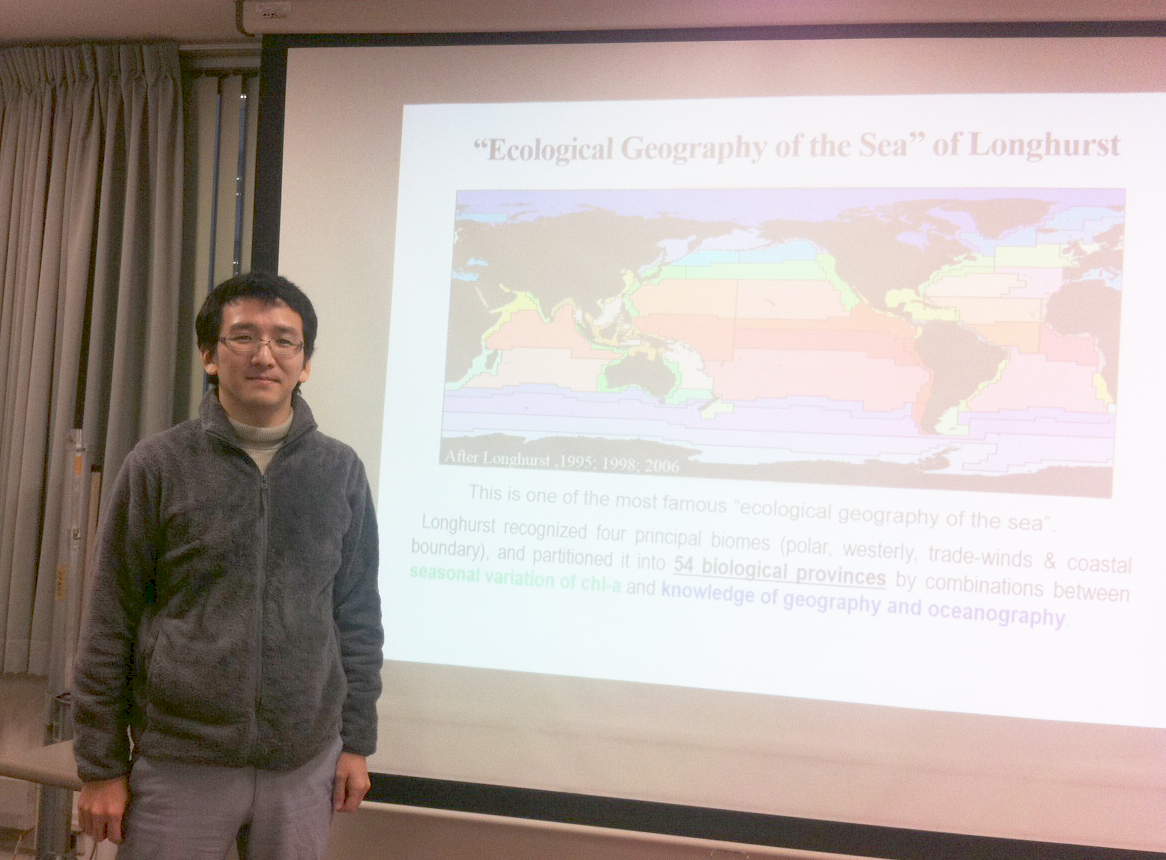
S. Lan Smith
"A simple size-based model of phytoplankton communities reveals size-scaling of phytoplankton growth traits in terms of observed allometries"
Abstract
Size is recognized as a meta-trait for plankton ecology, and allometric scalings have been derived for a variety of traits based on compilations of data from experimental studies. Plankton ecosystem models, even at the global scale, are increasingly incorporating size-scalings of phytoplankton traits, including half-saturation constants. For the sake of simplicity and computational efficiency, large-scale modeling studies typically apply Monod kinetics for growth, rather than resolving details such as the Droop quota model and nutrient uptake kinetics. However, data-based allometries typically include the Michaelis-Menten half-saturation constant for nutrient uptake, Ks, rather than that for growth, Kμ. It has long been known that Kμ must be less than Ks, i.e., that growth saturates at lower nutrient concentrations than does nutrient uptake, although the precise relationship between their respective size-scalings was not known. We present a new simplified model of phytoplankton communities, which accounts for biodiversity via size-scaling of phytoplankton traits and for flexibility of the C:N ratio of biomass. In terms of this model framework, we derive the size-scaling of Monod parameters in terms of the scalings of Michaelis-Menten and Droop parameters. This implies a weaker size-dependence for Kμ, compared to that typically reported for Ks. This scaling relationship, which can also be expressed in terms of affinity rather than half-saturation ‘constants’, provides a basis for consistently incorporating observed allometries into models based on Monod growth kinetics.
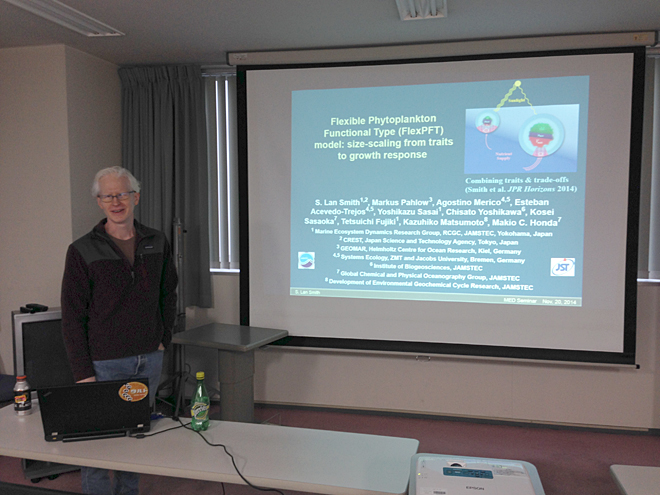
Nov 6, 2014
Koji Sugie
"Interactive effects of temperature and ocean acidification on phytoplankton communities in the subarctic North Pacific – preliminary results –"
Abstract
On-board incubation experiments were conducted at 47.5°N 160°E and 47.5°N 150°E in summer 2014 to test the interactive impacts of ocean acidification and global warming on diversity of phytoplankton and biogeochemical cycling of bio-elements. In this preliminary result, I can show only temperature and light conditions, chlorophyll-a, and dissolved inorganic carbon (DIC) concentrations. Fe addition significantly enhanced the growth of phytoplankton community at both sites, suggesting in situ phytoplankton communities were Fe-limited. Increasing temperature resulted in an enhanced growth of phytoplankton only at western site. Net DIC drawdown increased with pCO2 levels, suggesting carbon is consumed in excess relative to limiting nutrients such as nitrogen. I will confirm the possible feedbacks on atmospheric CO2 by measuring other parameters.
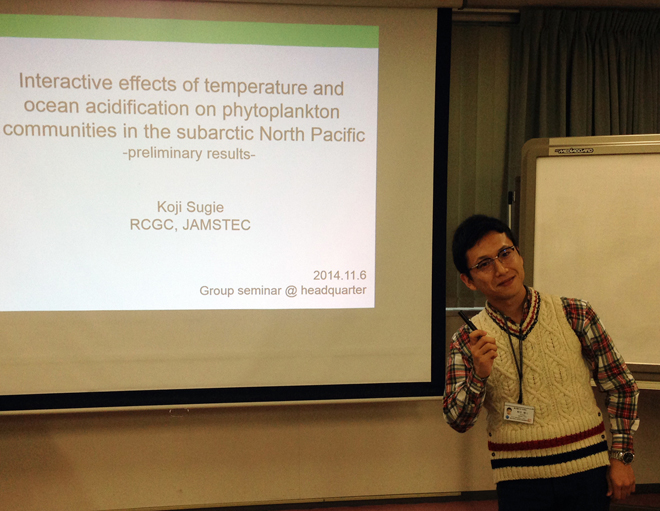
Jonaotaro Onodera
"Preliminary results on the sediment trap experiments in the western Arctic Ocean from October 2012 to September 2014"
Abstract
By the Canadian research cruise “Arctic Net Expedition 2014” in this September, three sediment trap moorings were recovered at Station NAP (75°N 162°W) in the southern part of Northwind Abyssal Plain and Station CAP (75°12.37'N 172°32.92'W) located on the shelf edge facing to the Chukchi Abyssal Plain in the western Arctic Ocean. Although the obtained samples are in the preparation of international shipping from Canada to Japan at this time, this presentation shortly shows some preliminary results on the mooring experiment. During the cruise, the sedimentation rate of total settling particles were roughly estimated based on the sediment thickness in the sample bottles of sediment trap. The early winter maximum of settling particle flux, which was characteristically observed in 2010 and 2011, was not observed in 2012. The absence of particle flux maximum in early winter 2012 probably reflects supply of oligotrophic basin waters to Station NAP. High particle flux in summer was estimated at Station CAP, probably because of eutrophic water input from the East Siberian Sea. I will also present short slide show on this cruise.
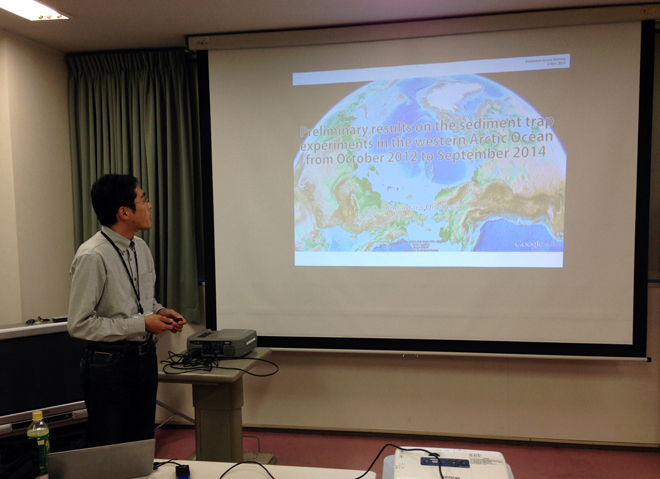
Oct 30, 2014
Markus Pahlow (Kiel Univ.)
"Optimality-based modelling of nutrient stoichiometry effects in mesocosm experiments off Peru"
Abstract
High nutrient concentrations in surface waters of the Peruvian upwelling region cause high rates of primary and export production, whose subsequent remineralisation creates an intense oxygen minimum zone (OMZ) at mid-depth waters. Strong fixed-nitrogen loss occurs as a consequence of sub- or anoxic remineralisation in the OMZ, leading to low dissolved inorganic nitrogen:phosphorus (DIN:DIP) ratios in the upwelling water.
A 7-day mesocosm experiment was conducted in order to investigate effects of different (low) DIN:DIP ratios on plankton processes. Here we apply an optimality-based plankton model with variable phytoplankton elemental stoichiometry in several configurations of different ecosystem complexity in order to analyse effects of stoichiometry and trophic structure.
Top-down control is revealed as a prerequisite to reproduce the development of the mesocosm plankton ecosystems. However, varying the trophic structure and variable phytoplankton stoichiometry alone do not suffice to explain the differential behaviour of the different DIN:DIP treatments. The differential mesocosm behaviour can only be reproduced by the model if zooplankton stoichiometry is varied according to the initial DIN:DIP treatments of the mesocosms. These results suggest an important role of micro-zooplankton stoichiometric regulation for the respons of plankton ecosystems to variations in the stoichiometry of inorganic-nutrient supply to the surface ocean.
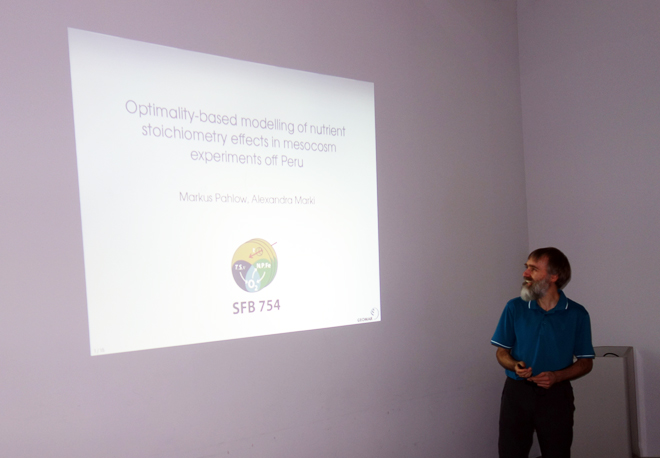
Kai W. Wirtz (Helmholtz-Zentrum Geestacht)
"Mesoscale patterns in phytoplankton blooms and their mechanistic roots in trait optimization"
Abstract
Phytoplankton forms the very base of marine ecosystems. Variability in phytoplankton concentration thus critically affects major ecosystem functions and services. However, the great spatio-temporal richness in bloom patterns since long challenges modeling. Here I present reconstructions of observed CHL concentration variations which were made using a mechanistic and trait-based model. Most formulations of the model were biophysically derived and validated using an extensive range of laboratory data. Its 3D implementation for a shallow, coastal sea then shows that spring blooms can be sufficiently well explained by fluctuating wind intensity and concomitant changes in water turbidity.
To the contrary, summer and autumn blooms not only reveal a strong spatial heterogeneity, but also reflect a more complicated factorial interplay. While physical forcing, with induced changes in nutrient and light availability, and zooplankton grazing have already been emphasized in the literature, this study unravels a novel (complementary)
mechanism: Phytoplankton traits such as mean community size or intracellular pigment partitioning exhibit a spatio-temporal pattern much different to that of bulk biomass. The underlying trait optimization most effectively amplifies growth rate in regions where environmental gradients lead to steep slopes in trait values. In the simulations, this leads to 2D filamentous structures of increased CHL concentration, which were repeatedly observed by remote sensing.
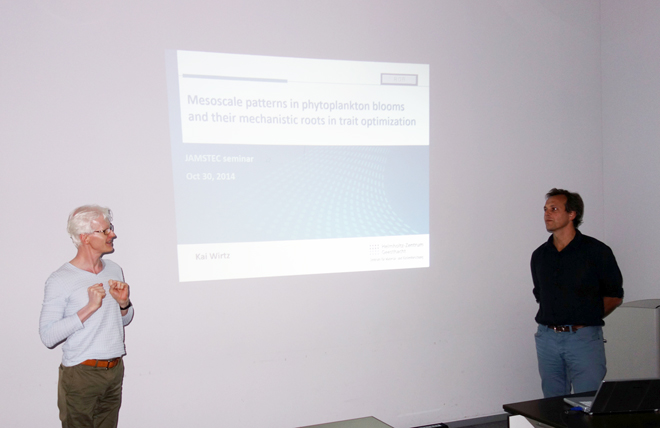
Oct 14, 2014
Tetsuichi FUJIKI
"Seasonal cycle of phytoplankton community structure and photophysiological state in the western subarctic gyre of the North Pacific"
Abstract
We investigated the seasonal variability of the phytoplankton community in the western subarctic gyre (WSG) of the northwestern North Pacific with respect to structure (abundance, size, and taxonomic composition) and photophysiological state from 2006 to 2012 by using the chemotaxonomy program CHEMTAX, microscopy, and fast-repetition-rate fluorometry. Chl a standing stock varied seasonally from 20 to 52 mg m-2 and increased frequently to > 40 mg m-2 in June and July. Diatoms (20-35%) and prymnesiophytes (13-23%) comprised major portions of the Chl a standing stock during the bloom period. Diatoms decreased to < 23% during the postbloom period, and prymnesiophytes became the most abundant group (24-35%). Mean Fv:Fm ratios (potential photochemical efficiency of photosystem II) in the mixed layer were relatively high (0.41-0.47) in winter and early spring, decreased rapidly to 0.32-0.39 concomitant with bloom development, and remained at low levels in the summer and autumn, although macronutrients in the mixed layer were not depleted at any time. In June 2012, onboard-ship iron (Fe)-enrichment experiments stimulated increases of Chl a concentrations (from 0.64 to 7.15 mg m-3) and Fv:Fm (from 0.33 to 0.44). Seasonal variability of the phytoplankton community in the WSG is controlled mainly by Fe, with light and temperature limitation occurring in winter and early spring. Our study also suggests that the magnitude and duration of blooms in the WSG are strongly affected by Fe availability.
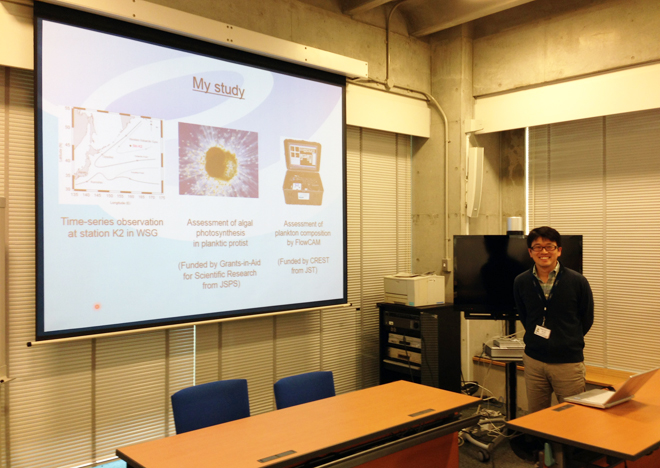
Katsunori KIMOTO
"Micro focus X-ray Computing Tomography Technique and its application for the Ocean Acidification study"
Abstract
The reduction of the oceanic pH―so-called ocean acidification (OA) ―is one of the most concerning issues of recent oceanic environmental change. The acidification of the ocean surface and subsurface water is a phenomenon already documented in the chemistry of the world ocean over the last two decades and it would affect shell development in various marine organisms that build external skeletons of CaCO3, but its effects are largely unknown and need to be quantified. Now, the Micro focus X-ray Computing tomography (MXCT) shed light on marine biology and OA study: MXCT has sub-micron special resolution for the object and become possible to measure morphology and density of body of organisms. Especially the application to the living and fossil foraminifera and pteropods might provide novel information about the OA ongoing in the modern ocean and occurred in the past. In this seminar, I will introduce about the MXCT technique and its application for our OA research in the North Pacific and Arctic Ocean.
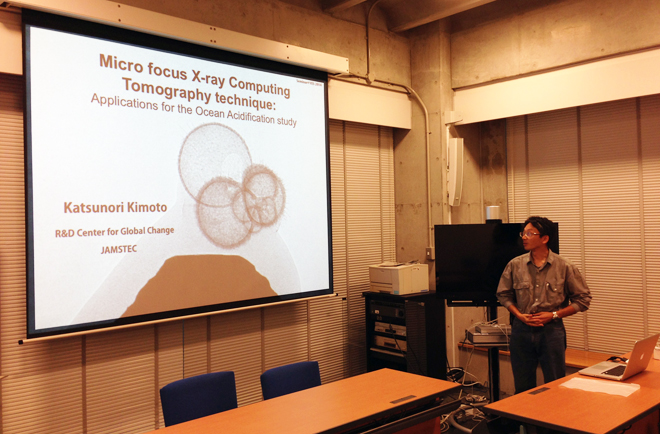
Oct 2, 2014
Tomoko Yoshiki
"Geographical distribution and phenology of warm-water species in the western subarctic North Pacific"
Abstract
Spatial and temporal variation of copepod community structure, abundance and biodiversity was examined in the western subarctic North Pacific (40-55ºN, 142-170ºE) during 2001-2010. The abundance of warm-water species group in summer was higher during 2009-2010, while cold-water species abundance decreased. Mean copepod biodiversity increased after 2006. We found a significant positive correlation between the warm-water species abundance and SST, and also copepod biodiversity in each sampling location. The most abundant warm-water species was Calanus pacificus which accounted for more than 90 % of the total abundance of warm-water species. C. pacificus occurred in higher SST area (>7.5˚C), and the distribution shifted northerly during 2008-2010. While, stage composition of C. pacificus was dominated by young copepodite stages in higher SST area, and significant negative relationship between abundance and average developmental stage was observed. The young stages were dominant in summer and autumn before 2008, whereas they were observed in spring-summer on and after 2008. The SST in the North Western Pacific was warmer during 2006-2010 than during 2001-2005, and this agrees with the PDO pattern. The warm SST in 2008-2010 was considered to have caused not only the northerly shift of distribution but also the phenological shift of the warm-water copepods.
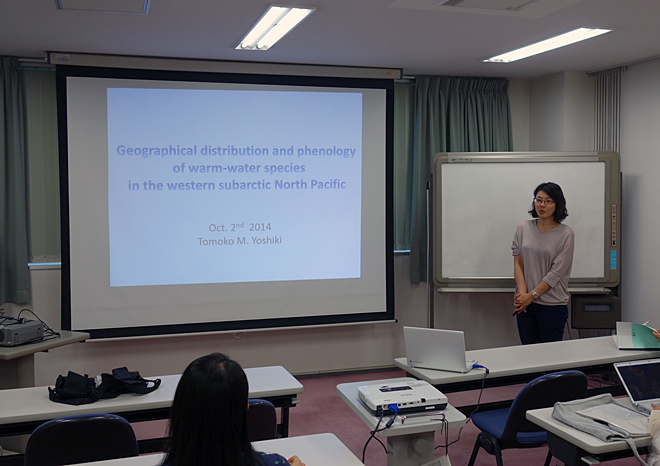
Kazuyuki Miyazaki
"Understanding the global carbon and nitrogen cycles from the combined use of multiple atmospheric observations"
Abstract
Global carbon and nitrogen cycles have been studied by combining observations of chemical compounds in the atmosphere with models using advanced inversion/data assimilation systems. I will present recent results from our group. (1) In the Earth’s atmosphere, carbon is mainly stored as Carbon Dioxide (CO2), Carbon Monoxide (CO), and Methane (CH4). We have investigated the impacts of various types of atmospheric concentration data obtained from surface, satellite (e.g., GOSAT), and aircraft measurements on the estimation of surface fluxes/emissions of these gases between the atmosphere and both the ocean and biosphere and from anthropogenic sources. Global carbon fluxes have been estimated for the period 1990-2011. (2) Important components in the global nitrogen cycle have been studied by combining various observational information with a chemical transport model. Data assimilation approaches have been applied to estimate lightning-produced Nitrogen Oxides (NOx) in the atmosphere, NOx emissions from biomass burning, soils and anthropogenic sources at the ground surface as well as those from ships, and Nitrous Oxide (N2O) emissions from human activities (e.g., agriculture) and natural sources (e.g., from the oceans).
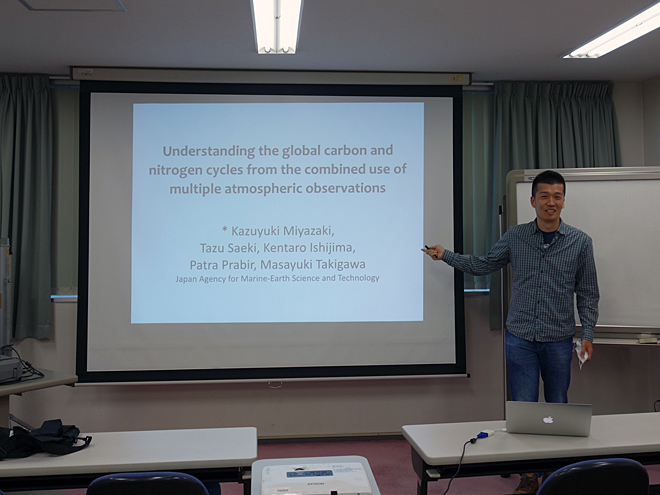
Sep 18, 2014
Fumihiro ITO
"Self introduction and DNAseq based phytoplankton composition and quantity analysis from sediment trap samples"
Abstract
Firstly, I am talking about my previous research topic. [Analysis the mechanism of adaptation/acclimation for low-temperature in E.huxleyi.] The coccolithophore E.huxleyi widely distributes from subtropical to high latitude oceans. Why high-latitude strains survive under low-temperature condition? I compared the property of photosystem parameter with high-latitude strain and low-latitude strain under low-temperature condition. I find that induction of plastid terminal oxidase activity is important to adapt low-temperature condition.
Second topic is [DNAseq based phytoplankton composition and quantity analysis from sediment trap samples.]DNAseq based phytoplankton composition analysis is already established and reported. However, no one reported DNAseq based phytoplankton composition analysis from sediment trap sample. Because, most of the sediment trap samples are fixed by formaldehyde, which strongly inhibit the extraction and amplification of DNA. I try to establish new method of DNA extraction and purification from formaldehyde fixed sediment trap samples.
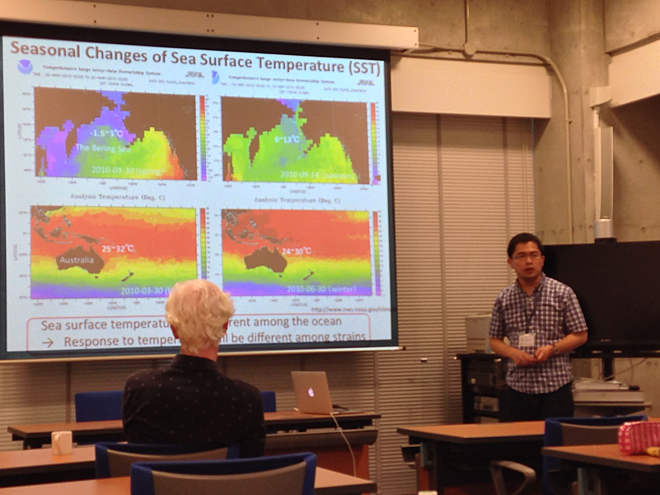
Haruka TAKAGI
"Photosynthesis of symbiont-bearing planktic foraminifers: Ontogenetic change, photophysiology, and host-symbiont relationship"
Abstract
Among modern planktic foraminifers, some species have developed photosymbiotic ecology with algae, and the photosymbiosis is assumed to offer a great advantage in inhabiting oligotrophic oceans. However, how host-symbiont association change through ontogeny or how photosymbiosis is involved in the host foraminiferal ecology is unknown and has never been investigated. Here, I will offer new insights for photosymbiosis based on photosynthetic characteristics of symbionts, obtained by in vivo fluorometric analysis (Fast Repetition Rate Fluorometry, FRRF). FRRF can identify photosymbiosis of individual foraminifer instantly in a non-destructive manner, and gives us various photosynthetic characteristics of symbionts, i.e., maximum fluorescence yield (Fm, index of chlorophyll content), photochemical efficiency (Fv/Fm, index of potential photosynthetic activity), and effective absorption cross-section of photosystem II (σPSII, capability of the absorbed energy to promote a photochemical reaction). In this talk, I will show the recent results obtained from culture experiments of two symbiont-bearing species, Globigerinoides sacculifer and Globigerinella siphonifera. Besides, I would like to discuss further application of FRRF on pelagic zooplankton, in terms of contribution on primary productivity and marine ecosystem.
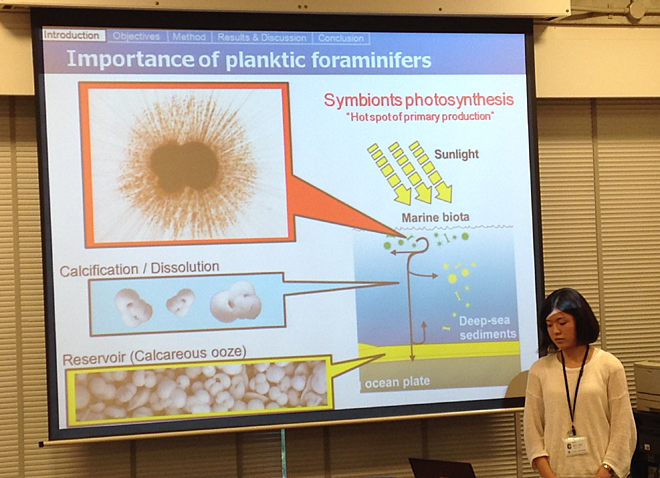
Sep 4, 2014
Maki NOGUCHI
"Development of Ocean biogeochemical model for new Earth System Model (MIROC-ESM)"
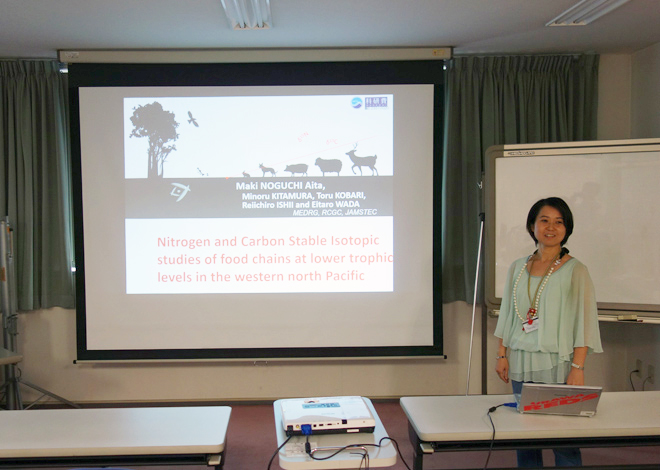
Eko SISWANTO
"Meridional differences on the factors determining phytoplankton biomass variation and spring bloom onset in the northwestern Pacific"
Abstract
Multi-sensor satellite-based and reanalyzed biogeochemical data were utilized to reappraise seasonal and meridional differences or spatial extents of factor(s) determining phytoplankton biomass (hereafter Chl-a) and mechanisms initiating Chl-a spring bloom in the northwestern Pacific Ocean where time-series stations of K2 and S1 were located. When all monthly data (all seasons) were included, close associations between Chl-a and geophysical variables emerged, seemingly reflected light-limitation and nutrient-limitation for Chl-a variations, respectively in the subarctic area (SAA) and the subtropical area (STA) with obvious transitional area around 37.5oN – 40oN. Those close Chl-a and geophysical variable associations were however largely overwhelmed by similarities in their seasonal cycles.
Reanalysis was then conducted for different seasons and also by removing seasonal cycles and trends of all variables. Clearly, light-limitation and nutrient-limitation areas, thereby their transitional area shifted seasonally. In regard with the mechanisms responsible for the spring bloom onsets, largely, there existed three hypothesis/mechanisms; the classical Sverdrup’s critical depth (CD) mechanism which applied largely over the area north of 40oN including the Oyashio area; mechanisms associated with mixed layer depth (MLD) cessation (stratification-onset) and turbulence weakening, that took place in the area roughly between 30oN and 40oN; and mechanism associated with rapid nutrient increase and/or dilution effect, which was more confined in the area south of 30oN.
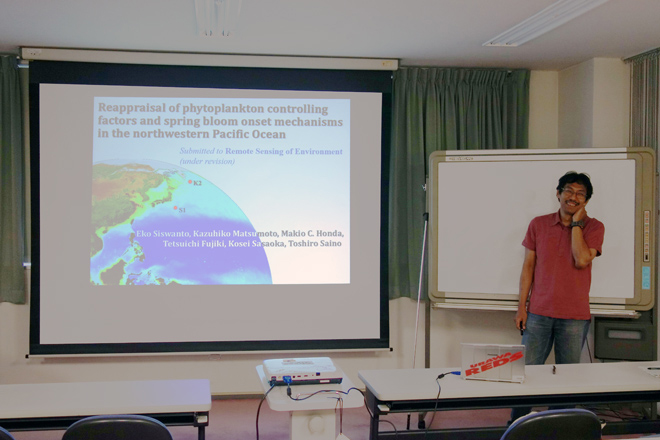
August 21, 2014
Taketo Hashioka
"Potential Responses of Phytoplankton Community Structure to Future Global Warming: Results from MAREMIPPhase 1 & CMIP5"
Abstract
In recent studies using high-performance liquid chromatography (HPLC) pigment data, empirical relationships between total chl-a concentration and a phytoplankton size/PFT fraction on a global scale are shown. For example, a fraction of diatoms increases with total chl-a concentration. The same tendencies can be seen in the most of the hindcast experiments by current PFT models of MARine Ecosystem Model Intercomparison Project (MAREMIP) and Coupled Model Intercomparison Project Phase5 (CMIP5) although the reproduced absolute values of a phytoplankton fraction still has large uncertainties. Then, two different mechanisms can be expected as potential responses of phytoplankton community to global warming. One is a possibility that the phytoplankton community structure (i.e., relationships between a phytoplankton fraction and total chl-a concentration) can be significantly changed by changes in ecosystem dynamics under global warming condition (e.g., changes in grazing pass/strength, decomposition/mortality/respiration rate and phytoplankton stoichiometry).
Another possibility is that the plankton community shifts to the other stable states associated with changes in total chl-a concentration (e.g., by decrease/increase in nutrient supply to the surface ocean by changes in
stratification) while maintaining the current relationship between a phytoplankton fraction and total chl-a concentration. To clarify impacts of both effects, we analyzed model results of future simulation, which was conducted by CMIP5 and MAREMIP under the RCP8.5 emission scenario. PFT model more than half showed that relationships between phytoplankton composition and total chl-a concentration are stable against environmental changes associated with global warming. In these model results, changes in phytoplankton composition are mainly caused by plankton community shifts associated with changes in total chl-a concentration. This result suggests the possibility that current empirical relationships obtained by HPLC would be maintained in a future environment. Based on this hypothesis, we project a potential future community structure of phytoplankton using a multi-model ensemble mean of future changes in total chl-a concentration with the empirical relationship of HPLC. Some other models projected large changes in the community structure in specific regions and seasons. These results also suggest potentially important mechanisms, regions and seasons.
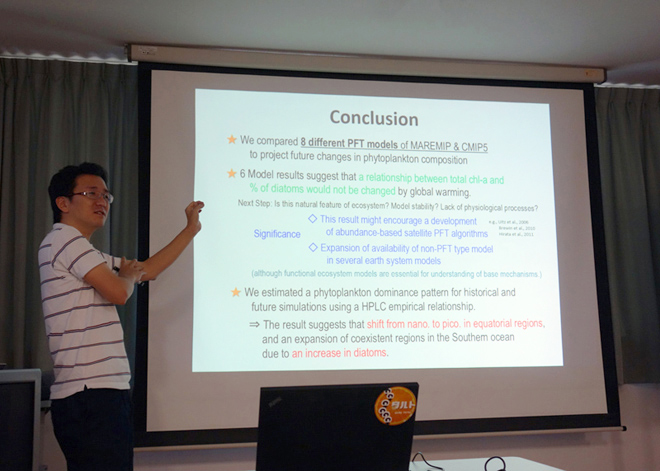
Minoru Kitamura
"Characteristics of zooplankton communities in the two time-series stations, K2 and S1"
Abstract
To understand ecological impact of mesozooplankton on the biological pump in the two time-series stations (K2 and S1), we investigated seasonal change of community structure with estimation of carbon demand and downward carbon transport by them. In the seminar, I will introduce characteristics of mesozoopalnkton communities. Zooplankton samplings were conducted during seven cruises from 2008 to 2012. Annual mean biomasses in euphotic layer were 2.5 (K2) and 0.2 (S1) g C m-2. Seasonal change of the biomasses was not corresponded to that of chl.a and primary productivity in K2, while peak timing of the maximum zooplankton biomass followed that of phytoplankton biomass and primary productivity in S1. Comparison of major taxa composition between the two stations and downward carbon transport by ontogenetic migration of Neocalanus cristatus in the station K2 will be also discussed in the seminar.
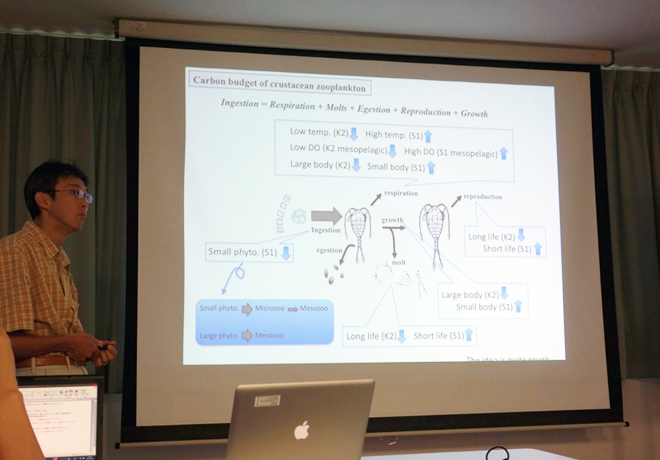
August 7, 2014
Sergio M. Vallina
(Institute of Marine Sciences (ICM) Spanish National Research Council (CSIC) Marine Biology and Oceanography)
"Global relationship between phytoplankton diversity and productivity in the ocean: killing-the-winner"
Abstract
The shape of the productivity–diversity relationship (PDR) for marine phytoplankton has been suggested to be unimodal, that is, diversity peaking at intermediate levels of productivity. However, there are few observations and there has been little attempt to understand the mechanisms that would lead to such a shape for planktonic organisms.
Here we use a marine ecosystem model together with the community assembly theory to explain the shape of the unimodal PDR we obtain at the global scale. The positive slope from low to intermediate productivity is due to grazer control with selective feeding, which leads to the predator-mediated coexistence of prey. The negative slope at high productivity is due to seasonal blooms of opportunist species that occur before they are regulated by grazers. The negative side is only unveiled when the temporal scale of the observation captures the transient dynamics, which are especially relevant at highly seasonal latitudes. Thus selective predation explains the positive side while transient competitive exclusion explains the negative side of the unimodal PDR curve. The phytoplankton community composition of the positive and negative sides is mostly dominated by slow-growing nutrient specialists and fast-growing nutrient opportunist species, respectively.
- http://www.nature.com/ncomms/2014/140701/ncomms5299/pdf/ncomms5299.pdf
- http://darwinproject.scripts.mit.edu/darwin/phytoplankton-diversity-versus-productivity-in-the-ocean/
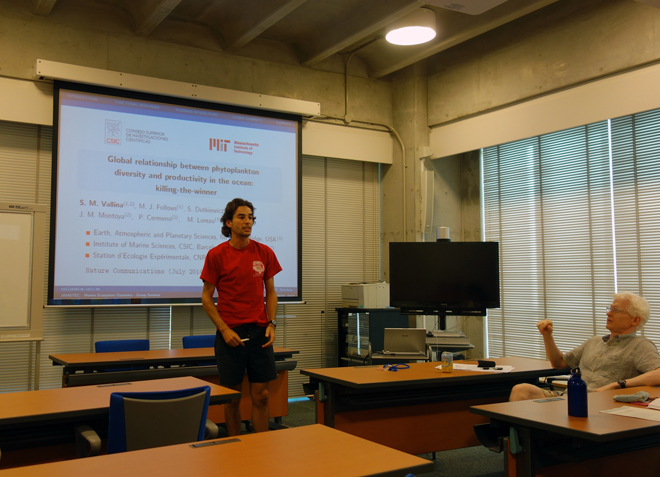
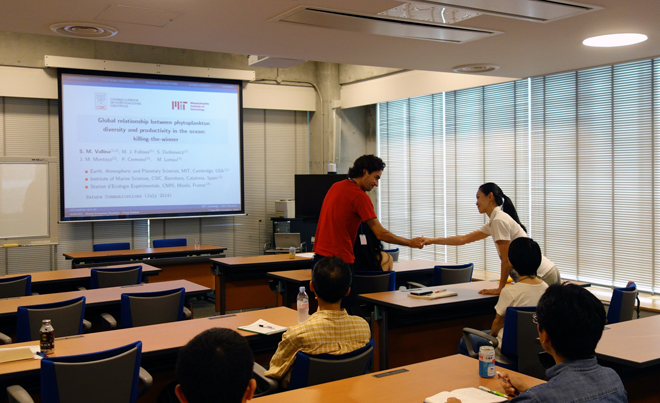
July 17, 2014
Sanae CHIBA
"Biodiversity and temperature in ocean - a tiny act of rebellion to the myth -"
Abstract
There is a conventional understanding that global plankton biogeography are largely controlled by temperature distribution, thus previous studies show its latitudinal gradient, low species diversity and large species dominance in the high latitude regions and high species diversity and small species dominance in the low latitude regions. This canonical pattern has been established based on the integrated analyses of plankton time-series data sets collected in the various regions. Some papers attempt to project possible influence of future global warming on global plankton biogeography and biodiversity mainly using the obtained relationship between temperature and plankton community structure while scientists are aware of the hidden mechanisms in correlations between the two. In fact, many long-term change studies have reported the spatio-temporal variation in plankton biodiversity that is discrepant to the temperature theory. This talk is to demonstrate such that cases we observed in the North Pacific regions based on the Odate collection data sets and North Pacific Continuous Plankton Recorder (CPR) data sets and discuss the complex mechanisms of variation of plankton biodiversity.
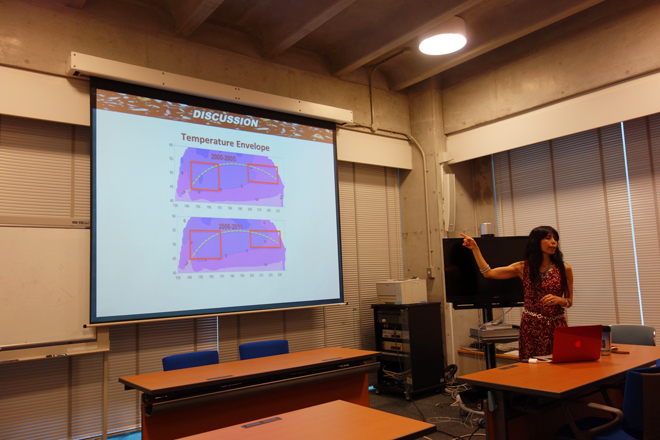
S. Lan SMITH
"Adaptive Phytoplankton Functional Type (AdaPFT) model: Size-scaling from traits to growth response"
Abstract
Recent studies have provided valuable data compilations and analyses of the size-scalings of phytoplankton traits, which nevertheless cannot be utilized directly in most large scale and long-term modelling studies because such models are typically formulated in terms of Monod growth kinetics, without explicitly resolving the underlying trait values. Furthermore, most such models do not account for the adaptive response of phytoplankton, as observed both for individual species and communities. Here we derive a simple adaptive model of phytoplankton growth by combining two optimality-based models, of growth and nutrient uptake kinetics, respectively, under the balanced growth assumption. This yields an explicit equation for growth as a function of ambient nutrient concentration and daily averaged irradiance, which can be expressed as an equation of Monod form, with effective Monod parameter values depending on both the underlying trait values and environmental conditions. The resulting framework expresses the overall growth response in terms of typically reported allometries for phytoplankton traits, thus allowing the latter to be applied directly in relatively simple models for large scale and long-term modelling studies. In applications to two contrasting time-series observation sites in the North Pacific, the new model gives improved response compared to a non-adaptive control model.
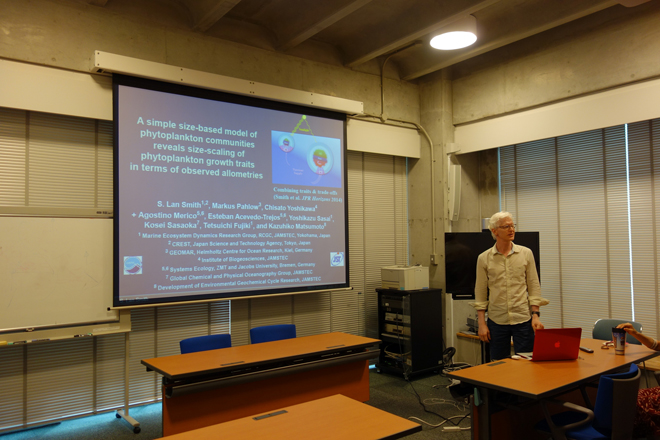
July 3, 2014
Kana NAGASHIMA
"Seasonal to interannual variations of the Asian dust input to the North Pacific"
Abstract
The knowledge of seasonality and year to year variations of Asian dust input to the North Pacific, especially to the HNLC region, is essential to examine the linkage between the nutrient supply through the dust and primary production in marine waters. Here I summarize the reported wet/dry deposition fluxes of Asian dust and its’ seasonal to annual-scale variations, and present still unsolved problems. Then I introduce my future study of the dust-transport seasonality and deposition flux using annual-laminated lake sediments from Japan and ice cores from Canada.
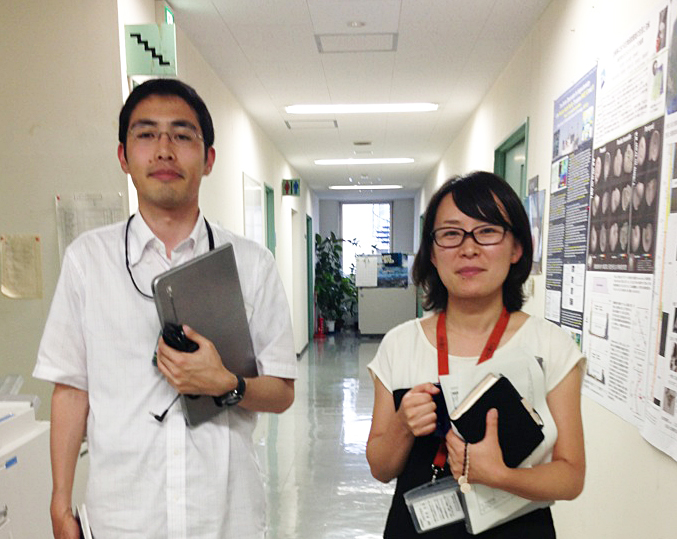
Jonaotaro ONODERA
"Interannual time-series observation of diatom fossil assemblages in the southern Bering Sea"
Abstract
I will briefly show multi-year scale variation of diatom fossil assemblages in the early late Pleistocene based on the detail observation of annual laminated sediments from the Bowers Ridge in the southern Bering Sea. The alternation of laminated and homogeneous sediments is observed in multi-decadal time scale. The interannual variations of sinking diatom flux and assemblage are larger than modern diatom flux and assemblage in the southern Bering Sea. The changeable environment in the early late Pleistocene is estimated from the observation of laminated sediments.
June 19, 2014
June 6, 2014
Abigail McQuatters-Gollop (Sir Alister Hardy Foundation for Ocean Science UK)
"Understanding large-scale change: Insights from the Continuous Plankton Recorder time-series"
Abstract
Unprecedented basin-scale ecological changes are occurring in our seas. As temperatures warm ocean pH is lowering, sea ice is decreasing, and marine stratification and nutrient regimes are changing. These unparalleled changes present new challenges for managing our seas as we are only just beginning to understand their ecological manifestations. Management toward a healthy ecosystem will take place against a background of climate-driven macroecological change. When setting environmental policy targets an understanding of large-scale ecological change in the marine ecosystem is also necessary. Knowledge exchange activities are often limited in funding, and the communication formats respected in the scientific community, such as peer-reviewed publications and scientific conference talks, are not appropriate to disseminate research to policy and decision makers. Consequently, scientific research may not be integrated in to the decision making process, with end users left either unaware of or not clearly understanding how science can support and inform management, adaptation and mitigation options. Much of our knowledge of macroecological change in the North Atlantic is a result of research using data gathered by the UK’s Continuous Plankton Recorder (CPR) survey, a near-surface plankton monitoring program which has been sampling in the North Atlantic since 1931. CPR data indicate that North Atlantic and North Sea plankton dynamics are responding to both climate and human-induced changes, presenting challenges to the development of pelagic targets for achievement of a good environmental status in European Seas. The CPR time-series is a crucial scientific tool for informing and supporting the sustainable management of our seas through policy mechanisms.
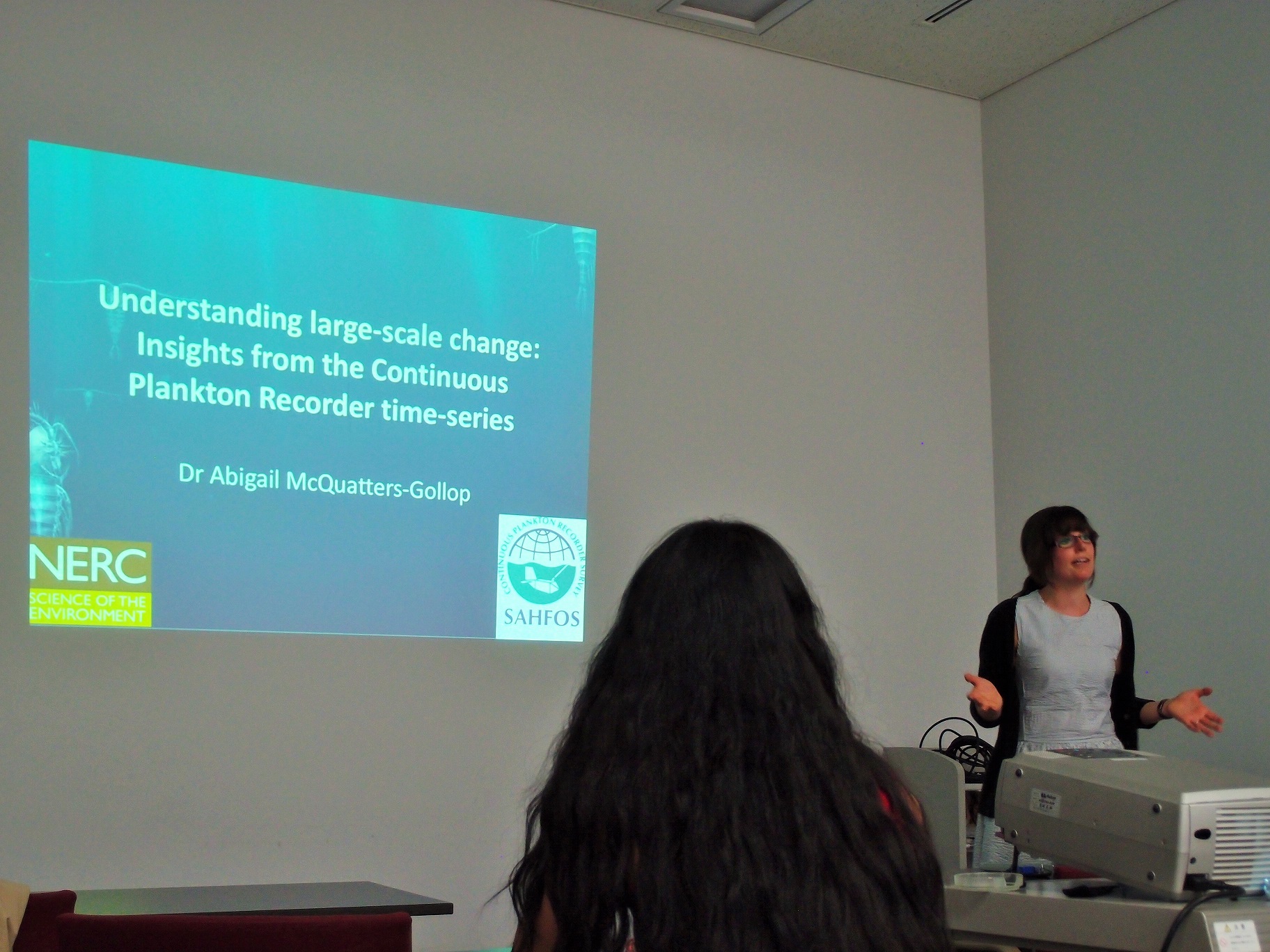
Jonas Rupp (Director Marine Policy – High Seas Issues, Conservation International Foundation)
"What do we know about what lies below? A new digital Global Seafloor Geomorphology Map and concept for understanding Global Ocean Life Distribution (GSFM-GOLD)"
Abstract
Ecosystem processes of the Earth’s eight major Ocean basins are important at ‘Earth system’, regional, national and local scales. The shape or geomorphology of ocean basins, and the geomorphic structures above and below the high-tide line influence physical oceanic inputs and flows, coastal and oceanic productivity, and provide habitats for marine living resources, as well as non-living resources used by people all around the world. Conservation and sustainable use of marine resources – including biogeochemical / ecosystem services – are affected by actions taken to implement political and legal commitments made by States (e.g. UN Convention on the Law of the Sea, Convention on Biological Diversity, Aichi Targets) and can be informed by scientific data, information and knowledge. We present potential uses of a new digital Global Seafloor Geomorphic Features Map (GSFM) – based on publicly available data from the Space-Shuttle and scientific cruises combined – which has been interpreted through a partnership between Geoscience Australia, UNEP-GRID Arendal, and Conservation International; together an analysis of geomorphic features in Japan’s Exclusive Economic Zone, in global and regional contexts. We also present practical observations on issues relevant to NGO’s constructively engaging with institutional processes – including inventory, assessment, management, planning, and capacity building; outlining some of the opportunities, and limitations faced by such efforts, including issues of credibility, legitimacy and authority. With current issues within and beyond national jurisdictions reflecting the capacity of States to manage their Exclusive Economic Zones (EEZs) – particularly as developed since 1982 when the UNCLOS was agreed – being able to place and understand what we know about largely unseen underwater habitats, in global, regional and national contexts provides an opportunity to identify priorities and take strategic actions. The GSFM is, amongst other things, a contribution by Geoscience Australia to the first World Ocean Assessment – due to be completed in 2015. We also present a concept for organizing in a spatially explicit way, what we know about Oceans, and developing in a structured way, a 5-year research program to consolidate our understanding of the physical and ecosystem processes that affect the Earth's 'Global Ocean Life Distribution' (GSFM-GOLD).
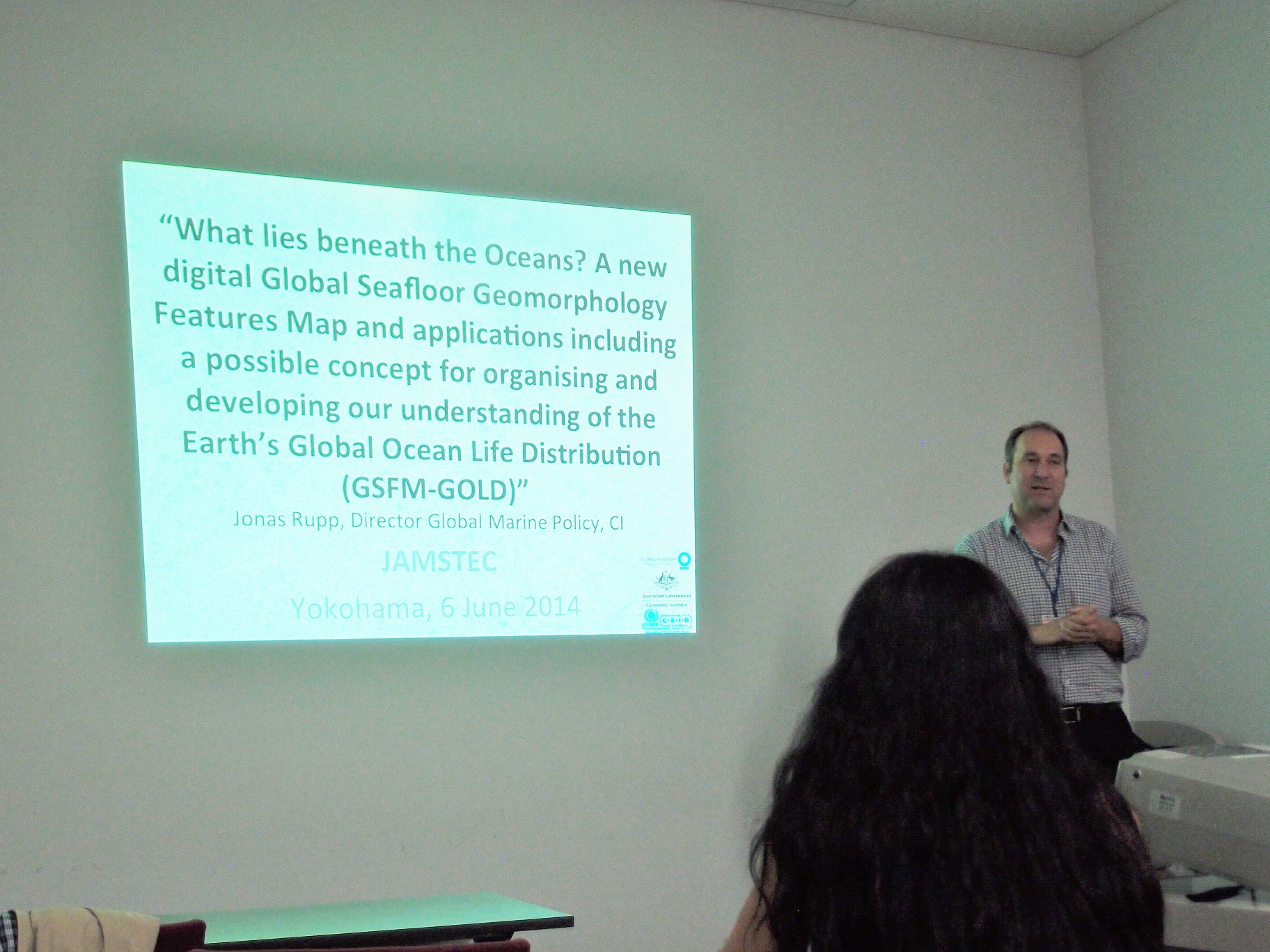
May 15, 2014
Naomi Harada GL
"Road map of Marine Ecosystem Dynamics Research Group"
Presentation material
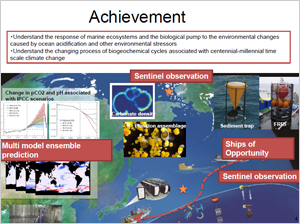
Road map of Marine Ecosystem Dynamics Research Group
Koji Sugie
"Self-introduction and Research Direction at JAMSTEC"
Abstract
Hi. I’m Koji Sugie new employee at RCGC, JAMSTEC. Let me introduce myself before my research direction at JAMSTEC. My research interest is the biology and ecology of diatom, specifically interaction with bioavailable iron and ocean acidification. I will conduct CO2 and temperature manipulation experiments in the subarctic Pacific in 2014 and in the Arctic in 2015.
Presentation material
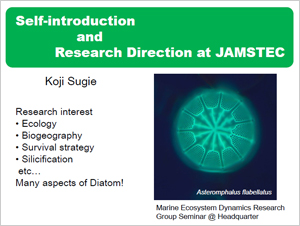
Self-introduction and Research Direction at JAMSTEC




